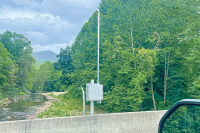An early account of Western NC
While crossing the Blue Ridge north of present Asheville in the early 1540s, Hernando de Soto’s scribes entered some brief descriptions of the landscape in their journals. In all likelihood, a letter written in 1674 by Abraham Wood, a Virginia merchant and Indian trader, contained the first descriptions of the mountainous terrain of Western North Carolina penned in the English language.
In a biographical sketch contributed to the American National Biography Online (2000), Virginia historian Alan Vance Briceland observed that, “Wood’s most significant contribution to the development of colonial America was as a participant in and organizer of English explorations of the Piedmont and the Appalachians. His goal, however, was not to open new lands so much as it was to discover an overland passage to the Pacific Ocean. Wood and others believed that the western ocean was just beyond the Appalachian Mountains.”
In 1673, Wood dispatched James Needham and Gabriel Arthur to explore “a southerly passage to the south or west sea” the Indians had described. Briceland contends that the explorers — accompanied by Indian guides — entered the mountains near present Asheville and emerged at Tomahitan, a Cherokee village near present Rome, Ga. Although the venture was a failure in that it convinced Wood that the Pacific Ocean lay beyond reach, it did provide colonial Englishmen with a more realistic concept of the geography of the continent.
After Needham and Arthur arrived at Tomahitan in early August 1763, Needham returned to Virginia to file an account of their journey with Wood. He was murdered along the trail while attempting to rejoin Arthur, who had remained with the Tomahitans, freely traveling with them on their raids and trading forays. According to Briceland, “In a year’s time, Gabriel Arthur had traveled approximately 3,300 miles — 2,500 on foot. He had perambulated the future states of Virginia, North Carolina, Georgia, South Carolina, Tennessee, Kentucky, and Alabama.” Aided by the chief of the Tomahitans, he was allowed to return on June 18, 1674, to Fort Henry, where he related his routes and exploits to Wood.
The only extant account of the travels of Needham and Arthur was provided by Wood in a letter dated Aug. 22, 1674. It was addressed to his friend John Richards, treasurer for the Lords Proprietors of Carolina in London. This letter was subsequently filed with the Shaftesbury Papers in the Public Record Office, London.
Needham and Arthur’s exact route over the Blue Ridge has been debated for more than a century. In his Westward from Virginia: The Exploration of the Virginia-Carolina Frontier, 1650-1710 (1987), Briceland made a convincing argument — based on the topographical descriptions the explorers provided as well as the average mileage they would have traveled each day — that they traversed the valleys, rivers and gaps through Western North Carolina from present Morganton (where the Indian village of Sitteree was located) to present Asheville, and westward from there through what is now Canton and Waynesville. Passing over the Balsam Gap just west of Waynesville, they proceeded to present Sylva and Bryson City and over the gap at Topton to present Murphy, “before passing into north Georgia just east of where the boundaries of North Carolina, Georgia, and Tennessee meet.”
Related Items
Whatever the exact route, Wood’s letter provided the first glimpse, however vague in regard to details, of the vast and complex range of mountains that lay between the Piedmont region of North Carolina and the valley of the Tennessee River to the west. This extract from Wood’s letter is based on an edited modern language text. I have entered notes in square brackets:
To my Honoured Friend, Mr. Richards in London, present.
About the 10th of April, 1673, I sent out two Englishmen and eight Indians with accommodations for three months, but by misfortune and unwillingness of the Indians before the mountains that any should discover beyond them, my people returned affecting little, to be short. On the 17th of May, 1673, I sent them out again, with a like number of Indians and four horses. About the 25th of June they met with the Tomahittans as they were journeying from the mountains to the Occhonechees [The Occaneechees were a small but fierce tribe then situated on a major trading path at present Clarksville, Virginia]. The Tomahittans told my men that, if an Englishman would stay with them, they would some of them come to my plantation with a letter which eleven of them did accordingly, and about forty of them promised to stay with my men at Occhonechee until the eleven returned. The effect of the letter was they resolved by God’s Blessing to go through with the Tomahittans ....
They journeyed nine days from Occhonechee to Sitteree, west and by south, past nine rivers and creeks which all end in this side the mountains and empty themselves into the east sea. Sitteree being the last town of inhabitance and not any path further until they came within two days’ journey of the Tomahittans. They travel from thence up the mountains upon the sun setting all the way, and in four days get to the top, sometimes leading their horses sometimes riding. [The party would have passed through either Hickorynut Gap or more probably Swannanoa Gap to access the plateau where Asheville is now situated.] The ridge upon the top is not above two hundred paces over; the descent better than on this side. In half a day they came to the foot, and then level ground all the way, many slashes upon the heads of small runs. The slashes are full of very great canes and the water runs to the northwest. They pass five rivers [in the Blue Ridge portion of North Carolina] and about two hundred paces over the fifth being the middle most half a mile broad all sandy bottoms, with pebble stones, all fordable and all empty themselves northwest, when they travel upon the plains, from the mountains they go down, for several days they see straggly hills on their right hand, as they judge two days journey from them. By this time they have lost all their horses but one, not so much by the badness of the way as by hard travel, not having time to feed. When they lost sight of those hills they see a fog or smoke like a cloud from whence rain falls for several days on their right hand [the Great Smoky Mountains?] as they travel still towards the sun setting great store of game, all along as turkeys, deer, elk, bear, wolf, and other vermin very tame. At the end of fifteen days from Sitteree they arrive at the Tomahittan’s river [in the Georgia piedmont], being the sixth river from the mountains ....
Ab Wood
From Fort Henry, August the 22nd, 1674
George Ellison wrote the biographical introductions for the reissues of two Appalachian classics: Horace Kephart’s Our Southern Highlanders and James Mooney’s History, Myths, and Sacred Formulas of the Cherokees. In June 2005, a selection of his Back Then columns was published by The History Press in Charleston as Mountain Passages: Natural and Cultural History of Western North Carolina and the Great Smoky Mountains. Readers can contact him at P.O. Box 1262, Bryson City, N.C., 28713, or at This email address is being protected from spambots. You need JavaScript enabled to view it..









